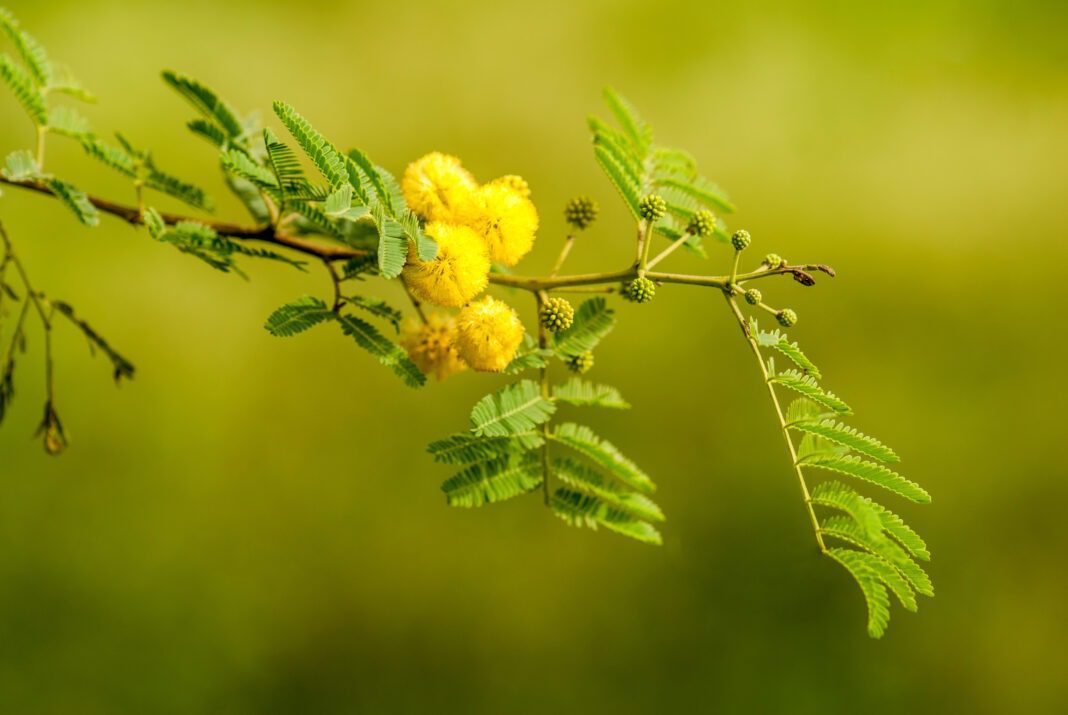Introduction
The plant Acacia nilotica belongs to the family Mimosaceae. It is a moderate-sized tree up to 10 m in height with dark brown or black rough bark and reddish-brown heartwood. The gum ‘gum Arabic’ exudes from cuts in the bark in the form of rounded or ovoid tears. Its color varies from pale yellow to black.
Botanical description of Acacia nilotica (1)
Acacia nilotica is a small tree (15-18 m) with a single stem.
Pods
These are 7-15 cm long, green (when immature), or greenish-black (when mature)
Seeds
8-12 seeds per pod, compressed, ovoid, dark brown shining with hard testa
Leaves
The leaves are bipinnate, pinnate 3-10 pairs, 1.3- 3.8 cm long
Flowers
The flowers are globular heads, 1.2-1.5 cm in diameter of a bright golden yellow color located at the end of branches.
Stem
The stems are usually dark to black colored, deep longitudinal fissured, grey-pinkish slash, exuding a reddish low quality gum.
Bark
The bark a tinge of orange and/or green (young tree), but older trees have dark, rough bark and tend to lose their thorns.
Thorns
Thorns are thin, straight
Gum
The gum varies in color from very pale yellowish-brown to dark reddish-brown depending on the quality of tannins in the sample.
Interesting point: The lighter the gum is the more highly valued.
Economic importance of Acacia nilotica
The plant is not only important for medicinal purposes but also is a highly valued plant economically. Acacia nilotica is used as a source of tannins, gums, timber, fuel, and fodder.
Therapeutic importance of Acacia nilotica
The plant is used as an astringent, antioxidant, anticancer, antitumor, diuretic, nerve stimulant, cold, cough, and congestion. The stem of the plant is used for toothbrushes and gums for burns. The bark is used for asthma, bronchitis, diabetes, dysentery, diarrhea, and skin diseases. The roots are used in liver complaints and the plant in cholera, hair fall, and syphilis. The leaves are useful in eye complaints and headaches, throat infection and urinary problems, gonorrhea.
Phytoconstituents of Acacia nilotica
The plant is rich in tannins, flavonoids, alkaloids, fatty acids, and polysaccharides (gums) (2).
Health benefits of Acacia nilotica
1. Acacia nilotica extract used as an astringent
The leaves, stem bark, and pods of the plant Acacia nilotica can be used as an astringent (3).
2. As a liver tonic
The gum and stem bark and root extract of the plant Acacia nilotica can be used as a liver tonic. It helps in detoxifying the liver. Studies show the antiviral compound in the plant which acts against the Hepatitis C virus (4).
3. Antiplasmodial activity of Acacia nilotica
Studies on animal models suggest that the alcoholic extract of the plants shows significant activity against the chloroquine-sensitive strain of Plasmodium berghei in mice (5).
4. Anti-hypertensive and anti-spasmodic activities
Different extract of plant parts particularly pods of Acacia nilotica shows Anti-hypertensive and anti-spasmodic activities. This helps in decreasing arterial blood pressure. The antispasmodic action of A. nilotica mediated through calcium channel blockade and also be responsible for the blood pressure-lowering effect as per studies were done on the animal model (6).
5. Antidiabetic activities of Acacia nilotica
Studies confirmed the anti-diabetic activities of the plant Acacia nilotica. The pods and tender leaves are considered very beneficial in folk medicine to treat diabetes mellitus (6).
Health benefits of different plant parts of Acacia nilotica
1. Leaves
The leaves of the plant Acacia nilota are used as an astringent, in eye complains and headaches, throat infection and urinary problems, gonorrhea. The aqueous extract of leaves shows an inhibitory effect on the mycelial growth of rice sheath rot pathogens (Saracladium oryzae) and the onion bulb rot and wilt the pathogen (Fusarium oxysporum f.). The tender leaves infusion used as an astringent and remedy for diarrhea and dysentery.
2. Stem and Bark
The stem and bark of the plant have antibacterial, antioxidant, anti-mutagenic, cytotoxic activity. The bark is used as an astringent, acrid cooling, styptic, emollient, anthelmintic, aphrodisiac, diuretic, expectorant, emetic, nutritive, in hemorrhage, wound ulcers, leprosy, leucoderma, smallpox, skin diseases, biliousness, burning sensation, toothache, leucoderma, dysentery, and seminal weakness. The trunk bark is used for cold, bronchitis, diarrhea, dysentery, biliousness, bleeding piles, and leukoderma (3).
3. Gum
The gum is said to be very useful in diabetes mellitus and has astringent, emollient, liver tonic, antipyretic and antiasthmatic properties (3).
4. Pods
The pods are used in impotency, urinogenital disorder, and dry cough
5. Seeds
The seeds and leaf extracts are used for general body vigor. It also shows Spasmogenic activity and antiplasmodial activity.
